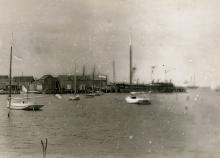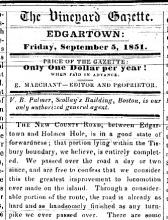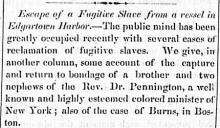Approximately 500 buildings in downtown Edgartown, most of them wood frame houses of the nineteenth and early twentieth centuries, are now part of a nationally recognized historic district.
Nearly all of downtown Edgartown was approved for listing in the National Register of Historic Places last fall. The national listing differs significantly from a local historic district. A national listing places no constraints on what owners may do with their property. It offers only prestige and some tax benefits to owners of income-producing properties. A local historic district must be approved by a two-thirds vote at a town meeting, and does place restrictions on what may be done with the buildings in the district.
Edgartown voters have rejected a local historic district three times at town meeting.
The nominations for the national listings were prepared by Victoria Distefano, who spent several years researching the project. The district covers about 150 acres, from the Edgartown harbor to Pease’s Point Way, and from the tip of Starbuck’s Neck to High street.
Of the 500 buildings in this section of Edgartown, only 77 are listed as “intrusions,” buildings constructed after 1913.
Miss DiStefano said the number of intrusions in the Edgartown historic district is relatively low compared with other New England towns. She said the Edgartown village is also unique: “It is very consistent, and it’s very compact. And it’s one of the very few whaling communities left that still has a lot of physical evidence.”
Nantucket and Marblehead are two other whaling villages which have been well preserved, Miss DiStefano said. But she added: “The other thing that is really surprising is that [Edgartown] has gone so long without being a historic district. The Nantucket historic district was created back in the early 1960s, as were many of the other older towns in Massachusetts. It’s very, very unusual that it’s taken so long here.”
But Miss DiStefano also said she has found that people in Edgartown are more aware of their history than in other places. She said, “A lot of small New England towns want to have a national register district to help promote an awareness, but I have found that the people in Edgartown seem to be naturally more aware, historically.”
In Edgartown the past proposals for a local historic district were strongly opposed by some residents. Now there is a historic advisory committee in town which was appointed to study the possibilities for a local historic district. But Miss DiStefano is not a strong advocate for a local district. “I’m more cautious than that,” she said. “No historic district should be established unless the people want it. It’s the kind of thing that’s meant to be there, only if the people want it.”
Three residents in the historic district have registered objections to the national listing, Miss DiStefano said.
Miss DiStefano said she has seen some attitudes change in Edgartown about a local historic district. She said, “I’ve heard so many people be dead-set against it. But I think more people are open to the idea now. [The national listing] makes people aware that what they have is special.
“The smaller the town the harder it is to set up a local historic district. And in a small town you want everybody to want it.”
Miss DiStefano said a local historic district bylaw can be very strict or very loose. “The hard part,” she said, “is deciding what goes into the bylaw.”
The history of the architecture in downtown Edgartown is laid out in great detail in the description on the nomination form for the National Register of Historic Places. Miss DiStefano wrote: “Local architecture tends to be conservative and idiosyncratic, both in its use of, architectural ornament and in its retention of vernacular building traditions long after they had passed out of use elsewhere in the state. During the 19th century, architectural styles often remained popular 10 to 20 years longer than on the mainland and frequently overlapped the introduction of more progressive styles.”
Architectural styles well represented in Edgartown include timber-frame houses and cottages, Federalist and Greek Revival buildings. Other styles represented, but with less frequency, are Italianate, Queene Anne, Colonial Revival, Arts and Crafts and Second Empire.
Miss DiStefano breaks down Edgartown’s architectural history into four periods: First Period Colonial (from the 1650s to 1775), Second period, Late Georgian and Federal Styles (1775 to 1835), Greek Revival Style Residential Development (1830-1865), and Victorian Architectural Styles (1850-1900.)
At least 12 buildings are associated, with the early settlement of Edgartown, or Great Harbor as it was first called. Miss DiStefano writes: “Several of the village’s earliest houses retain settings that reflect their construction prior to the development of the village’s grid of streets and the more usual local custom of building houses close to the street. Characteristic of houses that preserve elements of their original settings are the Captain D. Fisher house of ca. 1704 on North Water street, the Coffin-Dunham house on South Water street, a central chimney cottage at 119 South Water street, and the Thomas Cooke house of ca. 1765 on Cooke street.”
In the second period, when Edgartown became a more densely settled village, there are several variations on the styles, including half houses and cottage, three quarter houses and cottage, and full facades. Some examples of this period are the Obed Fisher house on South Summer street, the R. Coffin house on South Water street, and the Simpson house on Simpson’s Lane.
The Greek Revival style is all over downtown Edgartown. Miss DiStefano writes: “Accounting for approximately 125 houses within the district, the Greek Revival style is by far the dominant architectural style in Edgartown.
“The popularity of the style, its concurrence with a period of local prosperity due to whaling and the strong local building traditions that had developed by the mid nineteenth century combined during this period to produce a distinctive and idiosyncratic set of house plans and details that appear throughout the village.”
Examples of this period include the Thaxter house on Davis Lane, the Captain John Morse house and the Tristram Butler house on North Water street.
The Victorian period includes several styles such as Queen Anne and Italianate. Miss DiStefano writes: “The Italianate style is represented by several undecorated sidehall cottages and by several ambitious houses of which the Charlotte Inn of 1865 on South Summer street with its central gable, paired brackets, arched windows and cupola is the most fully developed example. Other well preserved examples include the Victorian Inn and the Captain Smith house.”
Besides the architectural narrative, other interesting bits of Edgartown’s history are revealed in the nomination form. The institutional buildings in Edgartown, also part of the national listing, were all designed by Frederick Baylis Jr. Mr. Baylis, the son of a Vineyard missionary, was born in 1795 in Edgartown and educated at Harvard. Mr. Baylis designed the Old Whaling Church, the Edgartown town hall (formerly a Methodist church), the Federated Church and the Dukes County Courthouse.
Miss DiStefano writes: “Most of the houses within the Edgartown village were not designed by architects, but by local builders and carpenters as well as ship builders and whaling captains, assisted by popular builders’ guides of the time.”
“However, one architect trained as such made a significant contribution to the architecture of Edgartown, especially public buildings.”
Mr. Baylis, she said, is also thought to be responsible for the design of a number of residential buildings in Edgartown, although none have been positively identified.





 1 comment
1 comment




Comments (1)
Comments